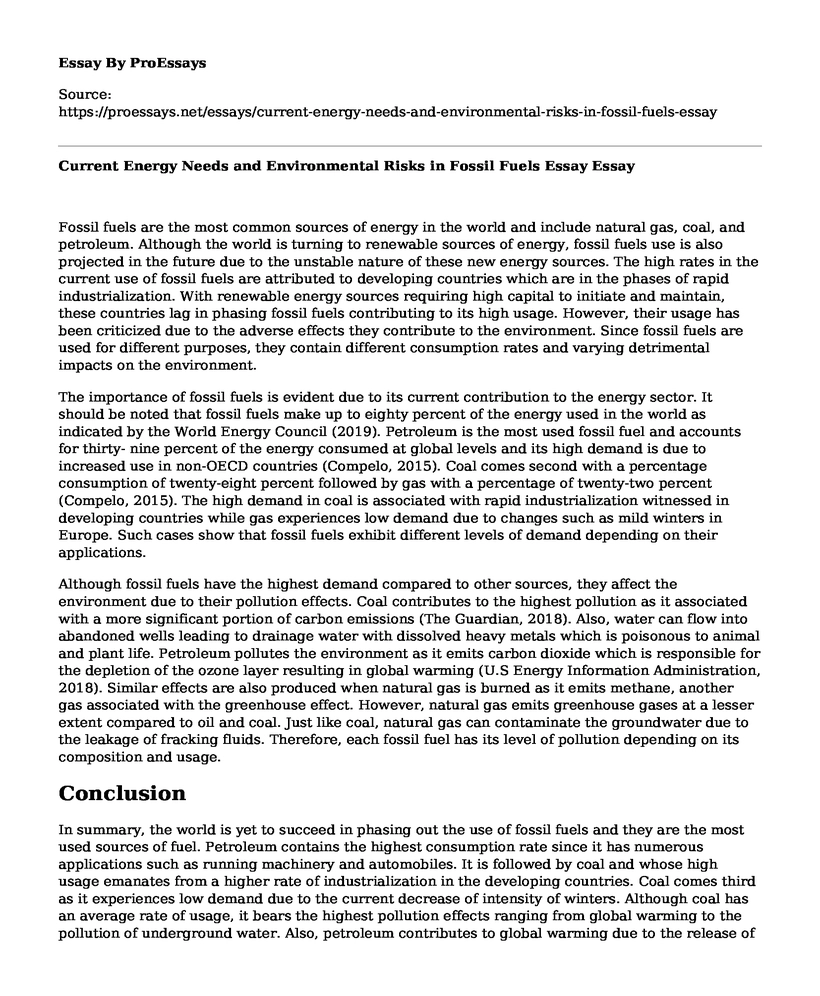Fossil fuels are the most common sources of energy in the world and include natural gas, coal, and petroleum. Although the world is turning to renewable sources of energy, fossil fuels use is also projected in the future due to the unstable nature of these new energy sources. The high rates in the current use of fossil fuels are attributed to developing countries which are in the phases of rapid industrialization. With renewable energy sources requiring high capital to initiate and maintain, these countries lag in phasing fossil fuels contributing to its high usage. However, their usage has been criticized due to the adverse effects they contribute to the environment. Since fossil fuels are used for different purposes, they contain different consumption rates and varying detrimental impacts on the environment.
The importance of fossil fuels is evident due to its current contribution to the energy sector. It should be noted that fossil fuels make up to eighty percent of the energy used in the world as indicated by the World Energy Council (2019). Petroleum is the most used fossil fuel and accounts for thirty- nine percent of the energy consumed at global levels and its high demand is due to increased use in non-OECD countries (Compelo, 2015). Coal comes second with a percentage consumption of twenty-eight percent followed by gas with a percentage of twenty-two percent (Compelo, 2015). The high demand in coal is associated with rapid industrialization witnessed in developing countries while gas experiences low demand due to changes such as mild winters in Europe. Such cases show that fossil fuels exhibit different levels of demand depending on their applications.
Although fossil fuels have the highest demand compared to other sources, they affect the environment due to their pollution effects. Coal contributes to the highest pollution as it associated with a more significant portion of carbon emissions (The Guardian, 2018). Also, water can flow into abandoned wells leading to drainage water with dissolved heavy metals which is poisonous to animal and plant life. Petroleum pollutes the environment as it emits carbon dioxide which is responsible for the depletion of the ozone layer resulting in global warming (U.S Energy Information Administration, 2018). Similar effects are also produced when natural gas is burned as it emits methane, another gas associated with the greenhouse effect. However, natural gas emits greenhouse gases at a lesser extent compared to oil and coal. Just like coal, natural gas can contaminate the groundwater due to the leakage of fracking fluids. Therefore, each fossil fuel has its level of pollution depending on its composition and usage.
Conclusion
In summary, the world is yet to succeed in phasing out the use of fossil fuels and they are the most used sources of fuel. Petroleum contains the highest consumption rate since it has numerous applications such as running machinery and automobiles. It is followed by coal and whose high usage emanates from a higher rate of industrialization in the developing countries. Coal comes third as it experiences low demand due to the current decrease of intensity of winters. Although coal has an average rate of usage, it bears the highest pollution effects ranging from global warming to the pollution of underground water. Also, petroleum contributes to global warming due to the release of carbon dioxide responsible for the depletion of the ozone layer. Natural gas contributes to global warming at a lesser extent as it mainly produces methane in smaller amounts.
References
Compelo. (2015). The worlds most used energy sources. Retrieved from https://www.compelo.com/energy/news/newsthe-worlds-most-used-energy-sources-4757903/.
The guardian (2018). Energy sector's carbon emissions to grow for second year running. Retrieved from https://www.theguardian.com/environment/2018/oct/08/energy-sector-carbon-emissions-grow-second-year-climate-change-coal.
U.S Energy Information Administration. (2018). Energy and the environment explained. Retrieved from https://www.eia.gov/energyexplained/.
World Energy Council. (2019). World energy council report confirms global abundance of energy resources and exposes myth of peak oil. Retrieved from https://www.worldenergy.org/news-and-media/press-releases/.
Cite this page
Current Energy Needs and Environmental Risks in Fossil Fuels Essay. (2022, Nov 15). Retrieved from https://proessays.net/essays/current-energy-needs-and-environmental-risks-in-fossil-fuels-essay
If you are the original author of this essay and no longer wish to have it published on the ProEssays website, please click below to request its removal:
- Research Paper on Fracking
- Appreciative Inquiry for Change Management Paper Example
- Future Technology Essay Example
- The Significance of Flint Towards Environmental Injustice - Essay Sample
- Essay Sample on Data Revolution: Unlocking Business Insights with the Power of AI and IoT
- Cellular Technology: Revolutionizing Communication - Essay Sample
- Research Paper Sample on Protecting Privacy on Social Network Platforms: Strategies







